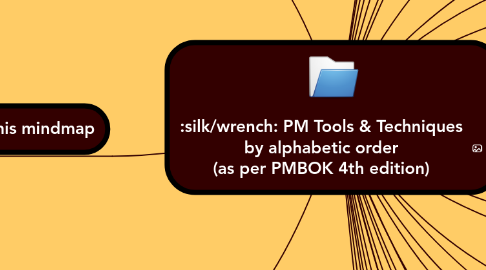PM Tools & Techniques by alphabetic order (as per PMBOK 4th edition)
저자: David Doret

1. Suggested links for further study
1.1. PMI
1.2. PM Podcast
1.3. PM Mindmaps
2. About this mindmap
2.1. Version
2.1.1. 1.5
2.2. Feedback
2.2.1. Email me your feedback, including ideas, comments and critics. If your would like to help me complete this mindmap with additional information, such as terms definitions extracts from the PMBOK, etc., your help will be much appreciated.
2.3. Future improvements
2.3.1. The next steps shall be: 1). Complete the inclusion of all process inputs, tools & techniques and process outputs. At this point, only half of the processes are fully documented. 2). Display a complete list of artefacts, display which contains or may contain which, etc. 3). Add definitions extracted from the PMBOK with due references to the book. 4). Decompose quality tools since there are many of these and include sample pictures of the various graphs that could be used. 5). Other ideas for improvement will be most welcome...
3. Legend
3.1. .
3.1.1. Initiating Process Group
3.2. .
3.2.1. Planning Process Group
3.3. .
3.3.1. Executing Process Group
3.4. .
3.4.1. Monitoring & Controlling Process Group
3.5. .
3.5.1. Closing Process Group
3.6. .
3.6.1. Project Integration Management
3.7. .
3.7.1. Project Scope Management
3.8. .
3.8.1. Project Time Management
3.9. .
3.9.1. Project Cost Management
3.10. .
3.10.1. Project Quality Management
3.11. .
3.11.1. Project Human Resource Management
3.12. .
3.12.1. Project Communications Management
3.13. .
3.13.1. Project Risk Management
3.14. .
3.14.1. Project Procurement Management
3.15. .
3.15.1. Process Input
3.16. .
3.16.1. Tools & Techniques
3.17. .
3.17.1. Process Output
4. What-If Scenario Analysis
4.1. Develop Schedule
5. Three-Point Estimates
5.1. Estimate Activity Durations
6. Templates
6.1. Define Activities
7. Stakeholder Analysis
7.1. Identify Stakeholders
8. Scheduling Tool
8.1. Develop Schedule
9. Schedule Network Templates
9.1. Sequence Activities
10. Schedule Network Analysis
10.1. Develop Schedule
11. Schedule Compression
11.1. Develop Schedule
12. Rolling Wave Planning
12.1. Define Activities
13. Resource Leveling
13.1. Develop Schedule
14. Reserve Analysis
14.1. Estimate Activity Durations
15. Questionnaires & Surveys
15.1. Collect Requirements
16. Published Estimating Data
16.1. Estimate Activity Resources
17. Prototypes
17.1. Collect Requirements
18. Project Management Software
18.1. Estimate Activity Resources
19. Product Analysis
19.1. Define Scope
20. Precedence Diagramming Method (PDM)
20.1. Sequence Activities
21. Parametric Estimating
21.1. Estimate Activity Durations
22. Observations
22.1. Collect Requirements
23. Interviews
23.1. Collect Requirements
24. Group Decision Making Techniques
24.1. Collect Requirements
25. Group Creativity Techniques
25.1. Collect Requirements
26. Focus Groups
26.1. Collect Requirements
27. Facilitated Workshops
27.1. Collect Requirements
27.2. Define Scope
28. Expert Judgment
28.1. Develop Project Charter
28.2. Identify Stakeholders
28.3. Develop Project Management Plan
28.4. Define Scope
28.5. Define Activities
28.6. Estimate Activity Resources
28.7. Estimate Activity Durations
29. Develop Schedule
30. Dependency Determination
30.1. Sequence Activities
31. Decomposition
31.1. Create WBS
31.2. Define Activities
32. Critical Path Method
32.1. Develop Schedule
33. Critical Chain Method
33.1. Develop Schedule
34. Bottom-up Estimating
34.1. Estimate Activity Resources
35. Applying Leads & Lags
35.1. Sequence Activities
35.2. Develop Schedule
36. Analogous Estimating
36.1. Estimate Activity Durations
37. Alternatives Identification
37.1. Define Scope
38. Alternatives Analysis
38.1. Estimate Activity Resources

